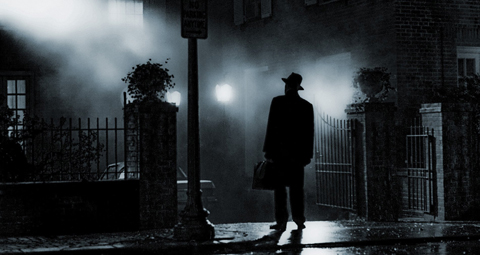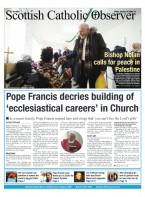October 27 | ![]() 0 COMMENTS
0 COMMENTS ![]() print
print

Catholic horror: how the Church becomes a haven of last resort in the world of the supernatural
EVE TUSHNET looks at the portrayal of Catholicism in scary movies, and how fright flicks often tap into society’s deep need for Faith -By EVE TUSHNET
WHEN there’s something strange in your neighbourhood, Who you gonna call? When there’s something weird—and it don’t look good, Who you gonna call?
In a wide array of horror movies, the answer to this theme-song question isn’t ‘Ghostbusters,’ it’s Roman Catholics. Whether you’re dealing with ghosts or vampires or things that go bump in the night, you’ll want people who know how to handle holy water.
No matter how much deserved criticism or casual contempt other kinds of films offer Catholics, in horror our Faith is often the haven of last resort. When nothing else can explain your situation and nobody else will help you, these movies suggest, turn to the Church: She can see in the dark.
The movies in which Catholicism is unexpectedly authoritative range from horror classics like ‘The Exorcist’ to popcorn-tossers like ‘The Conjuring’ series.
There are creepy if heavy-handed homiletic horrors like 2014’s ‘Deliver Us from Evil’, haunted-house tales like the ‘Amityville’ series, and exorcists every which way.
From the lapsed Catholic in desperate need of a relapse at the centre of ‘Rosemary’s Baby’ to the Catholic schoolgirls in the ‘70s proto-slasher ‘Alice, Sweet Alice’ (also known as ‘Communion’), we’re everywhere you don’t want to be.
These movies vary wildly in the quality of both their art and their theology. I’d recommend without qualification ‘The Exorcist’ and ‘The Elephant Man’ (which includes poignant funeral-as-Baptism imagery, and a model cathedral which serves as a sign of hope), but most of the other films in this genre are flawed at best.
Still, they’re ubiquitous enough to spawn articles with titles like, ‘Why are Catholic horror films so popular?’ and, ‘Why are so many horror films Christian propaganda?’
So why Catholicism? And it is Catholicism: other forms of Christianity don’t have the same authoritative weight in horror. The more ‘freelance’ your Faith, the less trustworthy you are in a horror movie—from Carrie White’s fundamentalist mom in ‘Carrie’ to the father in 2015’s tour de force of religious horror, ‘The Witch’, who is too severe for his Puritan community.
One unusual, poignant example is 1998’s ‘Urban Ghost Story’. Writer/director Geneviève Jolliffe’s low-budget horror takes place in Glasgow social housing, a tower block where a single mother and her children may be suffering from a neglectful landlord—or a poltergeist.
The bulk of the movie is spent on the family’s desperate search for explanations. They are shamed, disbelieved, and exploited by almost everyone they turn to.
Grieving 12-year-old Lizzie (Heather Ann Foster) turns to a minister to ask: “If I did something wrong, would I go to Hell?” The film cuts away before he answers, but his coyness about whether the Devil is real has suggested he might not have the straight answers she needs. So Lizzie has to resort to buying books like ‘Satanic Rites and How to Protect Yourself.’
Although the film’s ending is ridiculously rushed, it still manages real spiritual depth in its portrayal of guilt and forgiveness. Horror often deals with the incomprehensible breaking in on us from a terrifying world outside our normal life.
There are things in this world, horror films say, which exist outside our control, outside our understanding—and they don’t love us. The Church has a similar independence, a similar mystery—but a promise that she is on our side.
Although not every ‘Catholic horror’ film makes it as far as the promise. 2015’s intriguing French independent film ‘Neither Heaven Nor Earth’ follows a French troop facing unknown terrors in the Afghan desert.
After soldiers start to disappear, the captain calls for a chaplain. What he gets is an Afro-French priest, as cheery as a grinning skull, who scolds him for wanting to use God to comfort his men: “You think God is a teddy bear you hold at night?”
Instead of telling the men, as their captain suggests, that ‘God is love,’ this priest takes as his text the singularly uncomforting Job 16. This uniquely chilling scene drives the movie into the ‘flawed but fascinating’ territory shared by ‘Deliver Us from Evil’ and ‘Urban Ghost Story.’
Perhaps horror filmmakers are drawn in by the Catholic consecration of our physical bodies and physical objects to God’s service. Holy water, special clothes, ritual kisses and kneeling and the sign of the Cross—all of that is catnip to filmmakers. And because we believe that we will rise again, the bodies of the dead continue to hold special weight. We stick saints’ feet in jewelled reliquaries and make monastery chapels out of bones.
Catholicism can serve as a bridge to the other world because our religion is simultaneously everyday and exotic. Both priests in ‘The Exorcist’ have interests which take them into the secular world: Fr Merrin’s archeology, Fr Karras’ psychology. They exist in a world of MRIs and student protests. And yet they also have a responsibility to protect the victims of demons. Everybody basically knows what a priest is—and yet he can still stand as a sign of contradiction, a reminder of our hope of Heaven.
The way he lives doesn’t make sense if this world is all there is. The priest’s life is as painfully familiar as a hospital corridor, and as strange as war in Heaven.
And Catholicism is startlingly blunt about suffering. Every church has a crucifix; every church has the Stations of the Cross. Brute physical suffering is a huge part of our church’s visual alphabet—and that’s even before you get to ascetic practices or the agonies of the martyrs.
Loneliness, humiliation, and physical pain are portrayed in every church, not as things to be feared but as things to be shared with our Saviour.
If horror deals with experiences so harrowing that they might tempt us to believe life and suffering are equally meaningless, Catholicism confronts suffering directly—with a ferocity that even seems unseemly to people who haven’t yet needed it—and insists that suffering is a part of our imitation of Christ. Some horror films have earned the unflattering nickname ‘torture porn,’ due to their nihilistic dwelling on physical mutilation.
Catholicism, by contrast, depicts the torture of God Himself in order to make sure we never forget that His wounds are wounds of love: not meaningless, but overflowing with saving grace. And the Church is equally blunt about evil. Our Faith insists that sin is real, and horrifying.
These days we live in a moralistic age, where lots of people will agree that human beings do evil all the time (we are less convinced of the possibility of repentance and the duty of forgiveness than of the reality of human evil).
So what may distinguish the Church today is not solely belief in sin but belief in the Devil.
Pope Francis has been quite clear on this point: Satan is real. In 2014 he said in a homily: “We are all tempted because the law of our spiritual life, our Christian life is a struggle: a struggle. That’s because the Prince of this world, Satan, doesn’t want our holiness, he doesn’t want us to follow Christ.
“Maybe some of you might say: ‘But Father, how old fashioned you are to speak about the Devil in the 21st century!’ But look out, because the devil is present! The devil is here… even in the 21st century! And we mustn’t be naive, right? We must learn from the Gospel how to fight against Satan.”
Or, as the end titles of 2013’s ‘The Conjuring’ put it: “Diabolical forces are formidable. These forces are eternal and they exist today. The fairy tale is true. The devil exists. God exists. And for us, as people, our very destiny hinges upon which one we elect to follow.”
Against these terrifying realities, the Church offers… more terrifying realities. Reading Scripture you’ll notice how often God and angels have to tell people, ‘Do not be afraid.’ This is how an archangel starts a conversation! No teddy bear ever had to tell you not to fear him. God is large and strange enough to fear because He is large and strange enough to save.
In horror, the people you should trust are usually the people whose perspectives are dismissed in rational, scientific modernity. Dreams, folklore, urban legends—and orthodox religion: these are the ways of knowing vindicated in films from ‘Wolfen’ to ‘The Blair Witch Project.’ Children, the very old, the not quite sane—and priests: when the electric lights go out, these are the ones who can guide you through the dark.
This motley crew is a poignant reminder of religion’s weakness against the might of money, science, entertainment and the other-worldly powers of our age.
But ‘Catholic horror’ is also a promise, whispered in a room you thought was empty, that when all else fails and you are facing utter defeat at the hands of something you can’t hope to understand, there is an even higher power, a hope beyond this life, a fearful majesty come not to destroy but to rescue.










